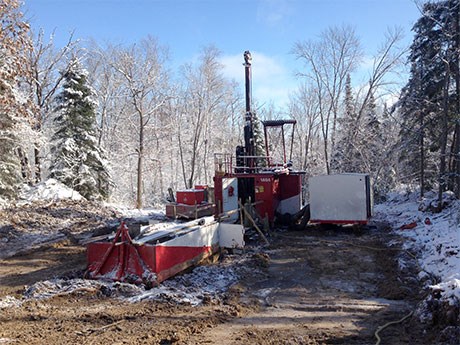Property on Sudbury’s Worthington Offset Dyke sits between Vale’s Totten Mine and KGHM’s Victoria project
Sudbury Platinum Corporation has started a drill program at its Aer-Kidd property on the Worthington Offset Dyke, 20 kilometres southwest of Sudbury.
The two Sudbury-based companies acquired Aer-Kidd from CaNickel Mining Company Limited in August 2014 for a cash payment of $1,250,000, eclipsing a previously negotiated option agreement that would have earned them a 70 per cent interest in the property.
Located 2.6 kilometres along strike from Vale’s Totten Mine and 4.3 kilometres southwest of KGHM’s Victoria project, the property has seen mining activity at shallow depths dating back to the late 1800s.
Transition Metals, led by former Falconbridge Limited veterans Scott McLean, Greg Collins, Grant Moore and Kevin Stevens, has a 48 per cent interest in Sudbury Platinum. Royal Nickel Corp. and a number of private investors own the remaining 52 per cent.
The decision to purchase Aer-Kidd followed a $1.2 million exploration program in April that focused on borehole geophysical surveys down some of the historically drilled holes on the property.
“We were able to define some really compelling targets using EM systems that weren’t available to historical explorers on the property,” said Transition Metals COO Greg Collins. “The previous systems that were used were effectively blind to the type of response associated with massive sulphides. They could see a broad zone of conductivity, but they couldn’t specifically pinpoint a target.”
A 4,500-metre drilling program began in October to test some of the most promising electromagnetic targets located beneath sites of historic past production to depths of up to 1,500 metres.
“We have been quite keen on the project for a number of years,” said Collins. Fortunately, CaNickel was going through some hardships and decided to divest their interest.”
Crowflight Minerals
From 2000 to 2004, Crowflight Minerals completed 29,200 metres of drilling in 48 holes targeting mineralization at depths of up to 1,250 metres.
“They had some encouraging results, but it was our feeling that they had the wrong technology and the wrong approach,” said Collins. “They ran into some challenges and made a decision to shift their focus to Manitoba, leaving Aer-Kidd to sit dormant in 2009-2010.”
Crowflight was acquired by a group of Chinese investors and in April 2011, the name of the company was changed to CaNickel Mining Ltd. The company’s Bucko Mine was a “challenging operation that pretty much consumed all of their time and is now on care and maintenance,” said Collins.
“The Aer-Kidd story is not unique. It’s a story that seems to be repeating itself in the Sudbury Basin,” he said, noting Vale’s commissioning of Totten Mine earlier in 2014 and KGHM’s decision to sink an exploration shaft at its Victoria project – both along the same Worthington Offset Dyke.
Totten has a 10.1 million tonne resource grading 1.5% nickel, 1.97% copper and 4.8g/t PGMs, while KGHM’s Victoria project boasts a 14.5 million tonne resource grading 2.5% nickel, 2.5% copper and 7.6 g/t PGMs.
“Crowflight went in too aggressively and not with the right systematic approach,” said Collins. “They drilled a series of very deep hail Mary type of holes on the property, one of which hit eight metres of 1.5% nickel, but they were unable to pursue it and they ran their bank account down.
They were a little out of their element in terms of how they pursued it. “The geology in Sudbury is unique and requires a specific skill set. Unfortunately, when you’re drilling $250,000 holes, the learning curve is not very forgiving.
“The target we’re focused on is down to a depth of one kilometre and more, so the process is deep, directional drilling and trying to make the most of the information you can get from those holes. That includes borehole geophysics.”
Transition Metals’ chief geophysicist, Kevin Stevens, was a senior geophysicist with Falconbridge for 15 years and shared the PDAC’s Prospector of the Year Award with Transition Metals president and CEO Scott McLean for the discovery that led to the development of Sudbury Integrated Nickel Operations’ Nickel Rim South Mine.
Project generator
A self-styled project generator, Transition Metals is also drilling the Sunday Lake platinum property 25 kilometres north of Thunder Bay through a 50:50 partnership with Implats, the second largest platinumproducer in the world.
In January 2014, Transition Metals reported intersections containing significant platinum-rich mineralization in four of six holes, including one intersection of 20.2 metres containing 3.22 g/t PGMs. The company has followed up these results with borehole electromagnetic surveys and further drilling to define the extent and continuity of the intersected mineralization.



.jpg;w=120;h=80;mode=crop)